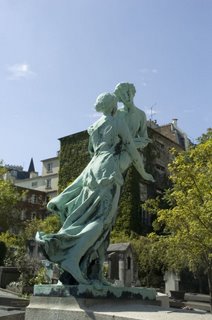 Although one of the smaller, more intimate burying grounds in historic Paris St. Vincent cemetery (opened in 1831) is recommended in the Culbertson/Randall book. (The authors refer to it as “the size of a sheet cake” and it’s really true.) Given the cemetery’s location in Montmartre, in a niche cut into the backside of Sacre Coeur it would also figure nicely into anyone’s walking tour through that part of the city. In fact you can walk up Rue Caulaincourt from Montmartre. Just watch out for Rue Lucien-Gaulard on your right, which is the entrance to the cemetery. Or you can take the Metro, and get off at the Lamarck stop. Upon exiting turn around 180 degrees and walk up the stairs to Place Pecqueur; Rue Gaulard is just across the street on your left. (photo: soaring statue above Rene Dumesnil.)
Although one of the smaller, more intimate burying grounds in historic Paris St. Vincent cemetery (opened in 1831) is recommended in the Culbertson/Randall book. (The authors refer to it as “the size of a sheet cake” and it’s really true.) Given the cemetery’s location in Montmartre, in a niche cut into the backside of Sacre Coeur it would also figure nicely into anyone’s walking tour through that part of the city. In fact you can walk up Rue Caulaincourt from Montmartre. Just watch out for Rue Lucien-Gaulard on your right, which is the entrance to the cemetery. Or you can take the Metro, and get off at the Lamarck stop. Upon exiting turn around 180 degrees and walk up the stairs to Place Pecqueur; Rue Gaulard is just across the street on your left. (photo: soaring statue above Rene Dumesnil.)There is a WC and office on your left as soon as you enter the cemetery. There were no maps available when I went – and according to Culbertson/Randall no official division of the cemetery is noted although Bertrand Beyern actually lists divisions in his classic “Guides des Tombes d’hommes celebres.” In any case, there is no large public map either, which is usually the case in most Parisian cemeteries. That said you might just want to stroll around this quaint little place, as there are some surprises here indeed – although I didn’t wax as enthusiastic about this as Culbertson/Randall; “it contains some of the most surprising statuary in Paris” was a bit strong. Still it is worth the stop.
 As soon as you enter the cemetery on your right the rather striking bit of sculpture over the tomb of caricaturist Candido Faria (7th division) and almost directly ahead of you, in what is certainly a standout position here is the fantastic sculpture found over the tomb of music critic Rene Dumesnil (8th division). And the next path up (running parallel with the main street) you will find the tomb of poets Papoue and Platon Argyriades (13th division): a quaint little “dollhouse” and peering out form the large glass picture window is a young couple, a man and a woman, presumably Platon and Papoue. Don’t miss it.
As soon as you enter the cemetery on your right the rather striking bit of sculpture over the tomb of caricaturist Candido Faria (7th division) and almost directly ahead of you, in what is certainly a standout position here is the fantastic sculpture found over the tomb of music critic Rene Dumesnil (8th division). And the next path up (running parallel with the main street) you will find the tomb of poets Papoue and Platon Argyriades (13th division): a quaint little “dollhouse” and peering out form the large glass picture window is a young couple, a man and a woman, presumably Platon and Papoue. Don’t miss it.There’s plenty more to see here so spend a while and browse. You won’t regret it.
You can see more photos online; just click here!
No comments:
Post a Comment